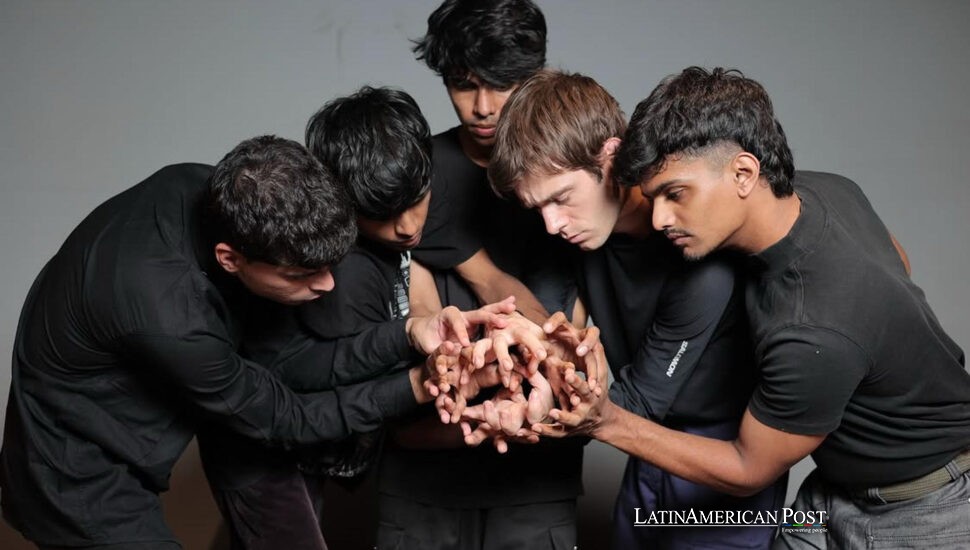How a Streetwise Argentine Choreographer Is Rewriting the Rules on Indian Stages

Long before the curtain call in Delhi’s Kamani Auditorium, the lights were buzzing, the chalk symbols drawn, and five dancers stood ready. Daniel Pannullo had pulled hip-hop from phone screens and dropped it into live theater, daring audiences to see dance in a new light.
From Patagonia to New Delhi, a Journey Through Movement and Memory
Daniel Pannullo was born in Comodoro Rivadavia, a windswept city in Argentine Patagonia that few tourists visit and even fewer artists claim as their training ground. Today, he lives in Madrid—but, by his own account, his creative path runs through Kerala.
“I first came to India to study Kalaripayattu,” he told EFE, referencing the ancient martial art. “But I stayed because movement here is history, emotion, resistance.”
Now back in India after more than a decade, Pannullo has returned not with swords or stances, but with “Lo incorpóreo”, a restless, genre-breaking piece that fuses Instagram-famous street styles, traditional Indian gestures, and European theatrical structure.
His collaborators? Not classically trained dancers, but battle-tested stars of India’s digital underground.
“These forms come from neighborhoods—usually forgotten ones,” Pannullo said, gesturing at the chalk-drawn stage where rehearsals had just finished. “Before they go viral, they’re raw and personal. I want to bring them back to that.”
Dr. Priya Ramachandran, a dance historian at Jawaharlal Nehru University, sees this friction as essential. “When India’s movement traditions meet global street vocabularies, something powerful happens,” she explained. “You see the rules—then you watch them dissolve.”
Viral Moves, Live Stage, No Safety Net
The cast is a live scroll of India’s online dance culture.
Hitesh, 25, has 130,000 Instagram followers for his bone-breaking isolations and gravity-defying transitions in Mumbai parking lots. Onstage, he breaks his viral rhythms—mid-shuffle, he locks, then twists his fingers into something resembling a mudra, only to collapse in slow motion as if an algorithm glitched.
“We come together and break typical dance rules to show our sense,” he told EFE backstage, between stretches.
The audience doesn’t always know when to clap—and that’s by design—some laugh, others pause, caught in the uncanny rhythm.
Cultural anthropologist Ananya Jain sees it as a pointed jab at the so-called “platform imperative”—the pressure, coined by researchers at MIT’s Center for Civic Media, to remain recognizable in a scroll-happy economy.
Another standout is Bishu Lotey, from Punjab, who slides his hands across his mouth so convincingly that it appears his lips are traveling across his face. The illusion is playful but disorienting.
“It’s about hiding stories in movement,” Pannullo said. “We all have things we don’t say with words.”
While the Delhi audience seemed to follow instinctively, thanks to their visual diet of Kathakali abstraction and Bollywood flair, the real test will come this fall when the piece tours Madrid, backed by Instituto Cervantes.
Between Reels and Reality, a Question of Survival
For many in the cast, the stage isn’t the dream—it’s a detour.
“We grew up battling,” said Harsh Parmar of Mumbai, referring to dance battles. “But if you want to survive in dance in India, you go to film.”
That reality shaped how Pannullo found his dancers. With TikTok banned in India since 2020, Instagram Reels became the primary channel for self-made choreographers. According to recent data from the Indian Institute of Management, dance content outperforms content related to food, fashion, and even cricket.
Still, clicks don’t pay the bills.
By paying European production rates, Pannullo temporarily freed his dancers from the audition hustle. That, he says, changed everything. “Once money wasn’t the pressure, they could take risks.”
Alexander Peacock, a London-based street dancer in the cast, says the connection felt immediate. “I grew up learning popping on YouTube,” he said. “They grew up building styles on Reels. There was no language barrier. Just movement.”
A Borderless Stage for a Collapsing World
For seventy minutes, “Lo incorpóreo” moves like a virus—slipping between Krump chest hits, Bharatanatyam shoulder flicks, and stark theatrical tableaus borrowed from Alessandro Fersen’s ritual studies. At one point, the dancers hold freeze-frame poses that resemble sculptures mid-decay.
Lighting designer Sandeep Jain paints the stage in deep crimson, nodding to childhood wedding shawls and the fever of performance itself.
Rogério Santana, an ethnomusicologist observing the production, calls it a case study in transcultural capital—a theory where artistic borrowing becomes a currency, not just a collaboration.
Pannullo prefers simpler language:
“Whoever climbs onstage is meeting beyond the norm, searching for something freer.”
That ethos echoes recent University of Seville research on post-migration art, which describes performance as a “third space”—one that transcends nationality, genre, or tradition. In that space, dancers no longer belong to reels or rituals. They belong.
Also Read: As Brazil Closes São Paulo’s Last Downtown Favela, Relief and Regret Collide
After the final bows in Delhi, Pannullo wasn’t packing up. He’s already organizing workshops in Dharavi, Asia’s largest informal settlement. The plan? Let local crews remix “Lo incorpóreo” using their phones, then send those new edits back out into the digital wild.
“I hope they break my choreography,” he said, smiling. “If rules have to break to make meaning, let them break mine.”
Because for Daniel Pannullo and his cast of rebels, reinvention isn’t a threat. It’s the entire point.





